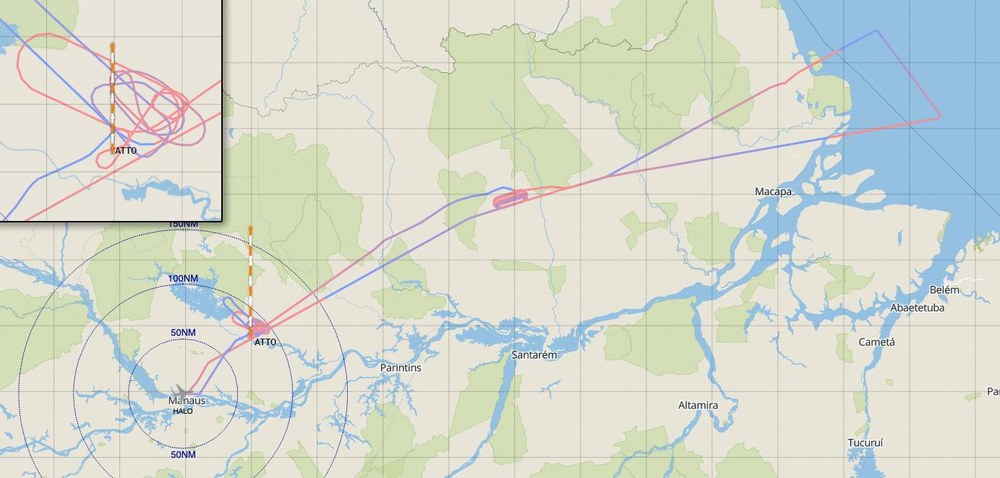Research in and high above the Amazon rainforest



MPIC/Dominic Jack with planet.atmosphere.aero/
- DLR's HALO research aircraft is currently flying over the Amazon.
- Chemical processes and cloud condensation over the tropical rainforest are the focus of the CAFE-Brazil research campaign.
- During 'helix flights', HALO 'spirals' from low altitudes up to 15 kilometres.
- Focus: Earth observation, climate change
The German-Brazilian research project Chemistry of the Atmosphere: Field Experiment in Brazil (CAFE Brazil) has kicked off. On 4 December 2022, an international research team led by the Max Planck Institute for Chemistry began collecting data on the chemical processes in Brazil's largely clean atmosphere above the Amazon rainforest as part of a campaign that will last approximately 60 days. Understanding natural chemical processes should help explain how factors such as air pollution affect the atmosphere. The HALO research aircraft from the German Aerospace Center (Deutsches Zentrum für Luft- und Raumfahrt; DLR) also forms part of the team. In addition to measurements using aircraft, data is also being collected with the help of balloons and drones and from the ground at the German-Brazilian Amazon Tall Tower Observatory (ATTO) research station. In addition to the MPI for Chemistry, the team includes researchers from Goethe University Frankfurt, Forschungszentrum Jülich, the Karlsruhe Institute of Technology, DLR, the Universidade de São Paulo, and the Instituto Nacional de Pesquisas Espaciais.
Seventy researchers are participating in the CAFE-Brazil expedition to Manaus in December and January. The airport of the capital of the Brazilian state of Amazonas is the take-off and landing point for the 20 planned measurement flights with the High Altitude and Long Range (HALO) research aircraft. The DLR-operated HALO aircraft – a Gulfstream G550 – is suitable for high altitudes and long ranges and is used for scientific research into Earth's atmosphere. For the CAFE-Brazil mission, the research team has equipped HALO with 19 instruments that will measure dozens of parameters, including aerosols, volatile organic compounds (VOCs), sulphur and nitrogen oxides, carbon monoxide, methane, ozone, free radicals and water. "The complex installation of the instruments and equipment on HALO took nine intense weeks in our hangar in Oberpfaffenhofen," says Thomas Sprünken from DLR's Flight Experiments facility. "Now we can finally start, and we are looking forward to an exciting mission in the rainforest."
"We expect to gain new insights into the chemical processes in the atmosphere above the tropical rainforest and into the interactions between the biosphere and the atmosphere to better explain the fundamental role of the rainforest in the terrestrial system," says Jos Lelieveld, scientific leader of the research expedition and director at the Max Planck Institute for Chemistry. Joachim Curtius, experimental atmospheric scientist and professor at Goethe University Frankfurt, is also excitedly looking forward to the research flights: " We are glad to be part of this important project and that it can finally get underway. Our focus is on the formation of particles from trace gases emitted by the forest." CAFE-Brazil was actually supposed to be launched in spring 2020, but had to be postponed due to the Coronavirus pandemic.
Measurement flights in the troposphere
The flights over the rainforest will follow set patterns to measure vertical and horizontal profiles. The plan also includes 'helix' flights, in which HALO spirals up from low altitudes to an altitude of 15 kilometres. The researchers want to use the aircraft measurements to find out how atmospheric oxidation processes take place in the troposphere above the Amazon rainforest and how they influence the formation and growth of aerosol particles, which are of central importance as cloud condensation nuclei.
The scientists also want to find the answer to the question of why the atmosphere's self-cleansing nature does not suffer over the rainforest, even though huge amounts of hydroxyl radicals are constantly being consumed. The chemical compound is considered a detergent for the atmosphere because it oxidises pollutants such as methane and produces water-soluble reaction products that are washed out of the air with the rain.
Coordinated measurements at the ATTO research tower
Studies conducted at the ATTO research station, a 325-metre-tall steel tower in the middle of the northern Brazilian Amazon rainforest, located approximately 150 kilometres from Manaus, will complement the HALO data. In addition to the climate observations at differing atmospheric heights, ATTO will enable research into the rainforest biosphere. A similar set of instruments is used on the tower as on HALO, providing a unique opportunity to link measurements in and directly above the rainforest.
The researchers want to compare the data sets obtained in the largely clean air above the Amazon rainforest with results that originate partly from previous survey projects that conducted measurements under marine and polluted conditions during research which focussed on air pollution. The HALO research aircraft was previously used for the Aerosol, Cloud, Precipitation and Radiation Interactions and Dynamics of Convective Cloud Systems (ACRIDICON) mission in 2014.
The Amazon rainforest has global ecological significance – it produces large volumes of oxygen, stabilises the global climate and influences the water and carbon cycle. Moreover, the rainforest generates large quantities of VOCs, such as isoprene. In turn, these form aerosol particles, which are important for the formation of clouds and precipitation.
